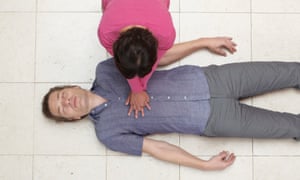We love this article at first aid courses in Canberra. We hope you enjoy this as well. We are trying to get the emphasis to schools in the local Canberra about the importance of first aid training for their staff but this article on explaining first aid to students/kids is great. Our first aid courses are designed for adults but we can come to you and complete a basic children’s first aid course so that they are aware especially of when to call 000. Some great ideas before you attend a first aid course here though.
“Mom, give me some ice.” Ranvir, 6, and Viraj, 4, hardly ever seem to get along. One can spot them getting on their mother’s nerves on several occasions. “Such is the case with siblings, especially boys, I guess,” says their mom, Smriti.
Last week however, Ranvir surprised his mother when he came running into the kitchen looking for ice. His brother had fallen off the bed and had got a bump on his head.
“Not only did Ranvir cajole Viraj, he even applied ice and an antiseptic cream on the wound,” says Smriti, proudly.
Smriti says that she feels a certain sense of relief knowing that her child is well equipped to be a caregiver in case there’s a need. “These are required skills you know and should not be looked upon as burdening the child.”
It’s comforting to know that children are competent, especially when it comes to first aid. “Nobody can misguide them,” she says. Plus, these are survival strategies that human beings should know.
Knowing first aid can be fascinating for children if we use the right methods. All we need to do is combine learning with our day-to-day slips and falls; our job is done.
Want to know how? Read the following 10 tips:
1) Wounds as stories
“I treat wounds while giving tips.”
Pranali, mother of a four-year-old, explains every step of the first aid that she gives to her child. Recently, he fell down the stairs and bruised his knee.
“I’m cleaning the wound with antiseptic first. This avoids infection,” she said as she started first aid. Then, she went on to explain that after cleaning, she is applying an antiseptic cream.
“I was crossing my fingers because he licks everything,” she chuckles and explains how her son took the tube of cream in his hands and looked at it as she applied.
“Shaurya stops crying and gets distracted when I involve him in doing his own first aid. I think he learns and remembers my tips,” says Pranali.
If you’re comfortable and calm while giving first aid to your child, you can help him/her remain calm during medical emergencies too. Also, you’re teaching first aid.
Sounds cool. Doesn’t it?
2) Replicate
“He’s a lot into superheroes. They thrill him,” says Ashish. His seven-year-old enjoys action-packed films and does not get anxious or scared when he witnesses accidents. That gave Ashish an idea to teach his son about first aid by replicating a few things at home.
“I used socks and cotton balls to display swellings,” when his son had wanted to see what a swelling around a wound looked like. Ashish also showed him the way to tie bandages.
“I put some tomato sauce on my arm, told my son that a wound bleeds like that, and taught him how to bandage it. The sauce made it fun!”
Ashish believes that there’s no harm being realistic with your children. They need to know how the human body reacts during adverse situations so that, god forbid, if they are in similar situations, they know what to do.
Makes sense!
 3) Play doctor
3) Play doctor
Well, this is a tried and tested, age-old method that still works. Playing doctor with young kids teaches them a lot about medical emergencies while maintaining a dose of fun.
“I don’t want him to get nightmares about cuts and wounds,” says Anamika. Her son is barely three and they’ve recently bought him a doctor’s kit. Since he wants to learn how to use it, she uses playtime to teach him about first aid.
“I know he is still too young, but I thought why not start now,” she explains.
Children learn fast when they find fun and relaxation in learning which is why Anamika feels that planning out serious first-aid sessions may not work with her son. During his natural urge for playing doctor, she is teaching her son about injuries, falls, and accidents.
“He listens to it like a story. Later, he’ll know better and by then, we’ll have bypassed the fear,” she exclaims.
 4) Make a kit
4) Make a kit
Mumbai-based preschool teacher Jhanvi tells me that making a first-aid kit together is a good way to teach children the uses of each thing that go into the kit.
It also helps them understand that the first-aid kit is to be used in case of an emergency, it isn’t a toy.
“Yes, many times my kids play with the kit and spoil the contents, especially creams. It’s risky but I need to keep the kit easy-to-reach too,” says Dipika, mother to two boys.
Making a kit together will work as a DIY activity as well as a session on the importance of first aid. Try it!
5) The priority list
“My daughter does not have patience to sit and listen. Even if it’s her favourite activity, I cannot make her sit for more than 10 minutes at a stretch.”
Ridhima’s daughter is like any other kid—she lacks patience. Making a priority list of problems where first aid might be required and teaching children about those aspects first, helps curb this problem.
So, what can be included in this list?
- Stopping a wound from bleeding
- Holding nostrils to stop a nosebleed
- Running a burnt body part under water
- Putting ice over swellings
“We made a decorated chart with kids where we drew different body parts and basic first aid for them. It was fun,” says Shradha from Notre Dame Academy, Patna.
Why don’t you try making a quick chart or list too?
6) ‘Might’ happen and not ‘will’ happen
“Don’t scare them by saying that these things will happen. That’s key to teaching first aid,” says Dr Thakrey from Mumbai-based Sai Swasthya Clinic.
“Make them feel like superheroes who have the power during any medical emergency,” he says. He explains that describing to children the gory details, plus how important it’s to manage oneself during a medical problem will scare them and first aid should work as a fun tool.
“Kids are smart enough to apply knowledge when needed, we need not push it,” he concludes.
7) All that breaks
“I introduced him to first aid for fractures by using a doll. By slowly bending the doll’s limbs, I spoke about cracked bones and he listened to me, mesmerised,” says Sheena.
Sheena is a dentist who is currently a stay-at-home mom. She enjoys passing on her medical knowledge to her six-year-old.
Sheena says that talking to kids about bones and blood supply grabs their interest. “These things are real and there’s a lot of fun in reality,” she says. She has explained to her son that when bones get hurt, blood oozes out from them, which is why they hurt so much.
In these times, one must be patient with the person who is suffering the pain. Secondly, if he comes across someone who has fallen or is complaining of a hurting bone, he should immediately call another adult to help. Calling for help is also first aid.
First aid for fractures and sprains also means making the person who has fallen sit or lie down in a comfortable position. Not touching the hurting bone is the last, but most important rule.
“Helping out without a first-aid kit also comes under first aid, doesn’t it?” asks Sheena and I agree. Don’t you?
8) Raise an alarm!
“They should know that calling an adult to help is sometimes the best help they can provide,” says Dr Thakrey.
Shalini, a marketing executive with a cosmetics firm and mother of two, says that children should be taught to raise an alarm. It’s not their job to assess a situation. By raising alarms during medical emergencies, they will help themselves out of the situation and help the person in need too.
So, teach them to raise an alarm!
9) Mind over matter!
“We dropped him and went grocery shopping next door. Our cell phones were out of reach in that basement shop. He managed alone!”
Swayam had hurt himself at the football field and was feeling faint after that. His coach did some first aid and thereafter, tried calling Swayam’s parents. He was not able to get across to them, but felt helpless since the rest of the team of six-year-olds could not have been left unattended.
While Swayam sat in a corner and waited for his parents, he decided to breathe and stay calm. He pulled out his napkin and pressed his wounds till he felt better.
“We arrived and panicked when we saw the coach panicking around him. But our son stayed calm,” say Swayam’s parents.
They add that we might not always have resources for first aid and even if we have them, they may not work if there is no presence of mind. So along with first aid, teach your kids to employ their minds too!
10) A kid is but a kid!
“Every time I talk about first aid, I talk about personal safety first,” says Swati.
She believes that the safety of her two sons is more important than them helping out. “You can’t jump into a pool to save someone even if you know how to swim,” she tells her kids.
Dr Thakrey says, “Kids are taught first aid to help. That does not mean that they fix other’s problems on their own. They also need to be taught whether a situation demands first aid or not.”
“Getting close to open wires, people who have burnt themselves, or someone injured on the road is not the business of kids,” he adds
“I don’t talk to my sons about all the scary things that might happen,” says Swati.
Don’t you think she’s right? Children need not worry about consequences as they learn first aid. All they need to focus on is that knowledge is fun and that they can help themselves if certain situations arise.
As they say, knowledge is power!
What are the ways in which you teach first aid skills to your child? Share a couple of ideas with us in the ‘Comments’ section below.



 3) Play doctor
3) Play doctor 4) Make a kit
4) Make a kit


 2
2